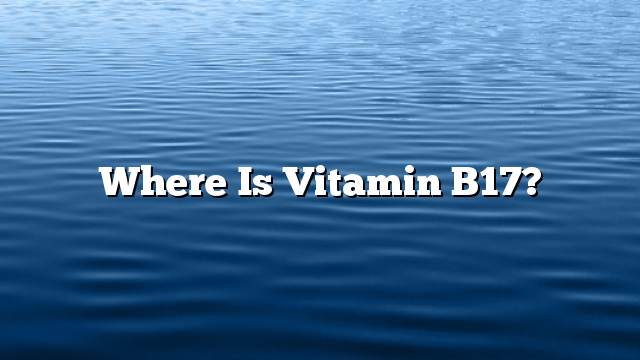Vitamin B17
Vitamin belongs to 17 or what is known as amygdalin (in English: Amygdalin) or inflicted (in English: Laetrile) to Alglakozydat group (in English: Glycoside), specifically Cianojenk Alglakozydat (in English: Cyanogenic Glucosides), which have been isolated from the seeds of the almond and apricot first time in 1830, and then the first time in the treatment of cancer used in Russia in 1845, to be used in the United States for the first time in the early twentieth century.
Although vitamin B17 is known by other names such as amygdalin or citrate, there is a difference between these two names. Amigdaline is the chemical formula with the partial formula C20H27NO11, which is found naturally in the nucleus of some fruits, such as almonds, apricots, Leterle is a semi-manufactured extract from amygdaline.
The amygdaline complex in the body breaks down into many compounds, eventually producing two compounds, Benzaldehyde and Hydrocyanic Acid. The supposed amygdaline effect in the fight against cancer is attributed to the hydrogen cyanide compound. It is worth noting that the amygdaline compound is not toxic in itself, but some of the products decomposed and analyzed in the body are toxic.
Although amygdaline is commonly called vitamin B17, it is not really a vitamin, but its use is used in the treatment of cancer in many countries of the world although it is not licensed as a cancer drug by the Food and Drug Administration.
Sources of vitamin B17
Amigdalin is found in the seeds of Rosaceous plants, such as almonds, peaches, apricots, peaches, plums and cherries. It is also found in lentils, beans, cashews, brown rice, and parsley (in Moroccan: Ilan).
Medicinal forms of vitamin B17
There are many forms of medicine for vitamin B 17 may be in the form of pills, or in the form of intravenous, or muscle, or anal, and may be in the form of lotion (lotion), and the treatment schedule is usually to give the patient vein vein for two to three Weeks, and then given vitamin B17 pills as a maintenance therapy, with the observation that the side effects are more severe when taking vitamin B17 by mouth compared to the injection.
Side effects of vitamin B17
The side effects of vitamin B17 are similar to the symptoms of cyanide poisoning.
- Headaches.
- Rotor.
- Nausea and vomiting.
- Blue; blue discoloration caused by hypoxia.
- Top eyelids drooping.
- Liver damage.
- Reduction of Blood pressure.
- Difficulty walking due to nerve damage.
- Fever.
- Turbulence and mental confusion.
- The coma.
- Death, as eating 50 grams (liter) may cause death.
Vitamin B-17 is linked to cancer
Vitamin B17 has been widely used as an alternative treatment for cancer in the past 40 years. Vitamin B 17 was widely used in the 1960s as a primary therapy or as part of metabolic therapy, which includes a special diet, a combination of enzymes and doses High in vitamins, bringing the number of people treated with vitamin B 17 more than 70,000 people in 1978 in the United States of America, was banned import in 1987, and then banned the use or circulation as a treatment in the United States and European countries.
According to pre-clinical trials conducted by the National Cancer Institute, the amygdaline complex has no therapeutic effect if given individually, or in addition to the enzymes that stimulate hydrogen cyanide, but has been observed to increase its side effects if given Amigdaline with the catalysts to be hydrogen cyanide, although there are no clinical studies comparing the effect of amygdalin use on cancer patients.
Vitamin B-17 is an unauthorized drug by the Food and Drug Administration. The neighboring state of Mexico is the most important supplier of vitamin B-17 despite the uneven quality of the product in terms of its purity and its components. Some products containing On bacteria and components unrelated to the product.
Hypotheses Mechanism of Action Vitamin B 17
Most hypotheses supporting the use of vitamin B-17 attribute the effectiveness of vitamin B-17 in the resistance of cancer to the compound of hydrogen cyanide (English: hydrocyanic acid), as some hypotheses explain its effectiveness based on the ability of hydrogen cyanide to kill cancer cells, and there are other hypotheses trying to support the hypothesis of the effectiveness of vitamin B 17 In the treatment of cancer, including:
- Some hypotheses explain the relationship between vitamin B17 and cancer that cancer is caused by a lack of vitamins and that vitamin B17 is one of those vitamins lost in the body, but there is no evidence that the literal acts as vitamin in animal or human, in addition to the lack of evidence The body needs it.
- Other hypotheses explain the relationship between vitamin B17 and cancer. The fact that some enzymes in cancer cells have a certain proportion makes vitamin B-17 toxic, and some evidence suggests that these enzymes are different between healthy cells and cancer cells.
Warning about vitamin B17
There are many sites that promote vitamin B17 as a successful treatment for cancer, although no recognized medical organization supports this assumption. Therefore, caution should be taken in the adoption or endorsement of this information.
